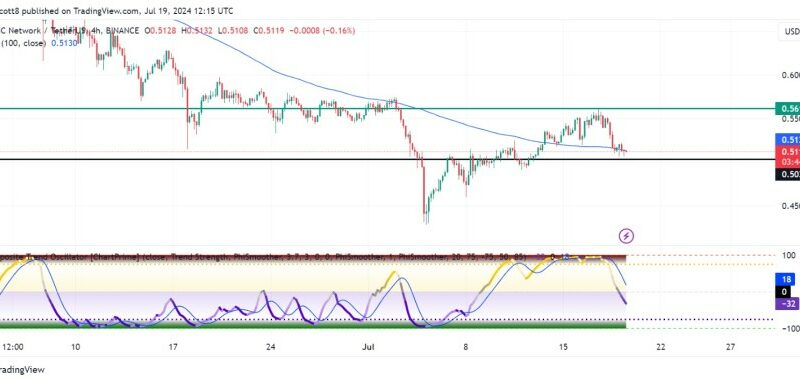Restoring trust to BTC in 2024: Let’s start with wrapping
The following is a guest post by Aki Balogh, CEO & Co-founder of DLC.Link
Bitcoin (BTC) entered 2023 with immense promise. Though subject to natural ups and downs, its momentum hinted at a maturing asset class poised for mainstream adoption. A year later, that promise has grown even further – particularly around the evolution of BTC ETFs. Yet, while the industry has observed an uptick in crypto adoption, institutional investors are hesitant and the political realm remains skeptical.
Building Trust
The industry grapples with a fundamental question: how do we restore trust in BTC and cryptocurrencies? Originally designed to decentralize ownership and control, they have often centralized and pooled assets, often with disastrous results.
One critical area demanding a trust overhaul is wrapped Bitcoin. Designed to integrate BTC with other blockchains, wrapped Bitcoin (wBTC) offers undeniable utility in Bitcoin holdings liquid, so as to be used in lending, staking and investing. Put simply, wrapped BTC holders can take advantage of the functionalities and advantages of DeFi without having to sell their BTC for ETH or other tokens. Yet, a glaring flaw – centralized custodianship – undermines the very purpose of wrapped BTC tokens.
Different from traditional BTC, wrapped BTC enables people to put their BTC to work within different blockchain ecosystems (Ethereum or Solana, for instance), allowing the BTC owner to unlock its liquidity to use in financial transactions.
Opening up these benefits to new audiences fosters a greater sense of financial inclusion and draws new people into the space. Overall, wrapped BTC’s success can enable institutions to view the industry more positively.
The Custodial Conundrum
However, wBTC has a glaring flaw in that it depends on one centralized custodian. Until recently, there was no way to wrap BTC for use in DeFi without introducing centralized custody. This custodian acts as the “trusted” third party responsible for safeguarding user funds, while simultaneously enabling compatibility between Bitcoin and whichever DeFi ecosystem it will be carried over to.
For example, to mint wrapped Bitcoin, BitGo (a US-based custodian) receives 1 BTC, holds it in their private vault, and issues a corresponding wrapped BTC to the owner so that they can move their BTC across chains and ecosystems.
Unsurprisingly, there are a variety of counterparty risks that can arise in crypto when an entire ecosystem depends on a third party. If this custodian unlocks the BTC to someone else – maliciously or erroneously – the underlying BTC is lost and the wrapped token becomes worthless for the rightful owner.
As the value of BTC continues its projected rise in 2024 (with some analysts suggesting it could peak at $150,000 by the end of 2025) users are becoming increasingly wary of such custodial risk. Imagine a scenario where your life savings, represented in wrapped BTC, vanish due to custodial failures, bad trades, counterparty risk, government/regulator seizures, or misappropriation.
Not to mention, under current legislation, FDIC deposit insurance coverage does not apply to non-bank custodians — thus implicating the majority of crypto companies offering custodial services.
The Illusion of Innovation
There are plenty of wrapped BTC options on the market, highlighting the demand that exists among BTC holders eager to bring their crypto to DeFi. The reality is that the vast majority of these options rehash the same custodial models and their inherent risks. In tandem with that, we have the rise of Bitcoin ‘Layer 2’ (L2) solutions adding another layer of complexity. These solutions entice users with high yields, often without adequately disclosing the underlying risks.
Here’s the truth: These L2s are not true second layers built on the Bitcoin blockchain itself but rather sidechains – separate blockchains tethered to Bitcoin. Bridging BTC to these sidechains exposes users to potential exploits and vulnerabilities that simply don’t exist on the secure Bitcoin network. Additionally, the promised yields offered by these L2s are often unsustainable. They rely on complex incentive mechanisms that cannot be maintained in the long run.
The Path to Trust
In this environment of eroding trust, there is one solution that can ensure that users retain full control of their assets. By utilizing discreet log contracts (DLCs) within Bitcoin, crypto merchants can establish a theft-proof bridge to wrap Bitcoin. DLCs, which are native to Bitcoin, were invented by MIT academic and Lightning Network co-creator Tadge Dryja.
Unlike their custodial counterparts, Bitcoin wrapped using DLCs enables users to maintain full self-custody of their BTC throughout the wrapping process with the support of a federated merchant network (similar to the design of USDC). This ensures the integrity of the wrapped tokens.
This federated model distributes risk across a large pool of participants, significantly reducing the reliance on any single entity – bringing decentralization back to Bitcoin. Just like the U.S. dollar is backed by a diverse set of assets held by the Federal Reserve, wrapped BTC incorporating DLCs is backed by a collective of merchants, eliminating the single point of failure inherent in custodial models.
The Future is Secure
We have seen Bitcoin withstand so many challenges so far and yet it continues to flourish – a testament to its strength. From my perspective, the future of Bitcoin is undoubtedly secure, particularly with the introduction of self-wrapped BTC and the incorporation of DLCs. These solutions, aligned with Bitcoin’s core value of self-custody, address a key concern: centralized control over wrapped assets.
While wrapped Bitcoin has seen adoption, its current centralized model concentrates risk and security hinges on user control and a commitment to decentralization – enter in DLCs. Imagine users holding the reins, wrapping and unwrapping their Bitcoin through secure, permissionless protocols. This fosters trust by empowering individuals, aligning perfectly with Bitcoin’s decentralized ethos.
Safety, not yield chasing or blind faith in untested solutions, should be the cornerstone of all financial technology. I believe wrapping solutions that empower users, not custodians, is the key to unlocking mainstream trust. Widespread adoption hinges on user confidence.
By prioritizing safety, user control, and responsible innovation, we can unlock Bitcoin’s true potential and revolutionize the financial landscape completely. Let 2024 be the year we move forward and rebuild trust in BTC, one secure wrap at a time.
The post Restoring trust to BTC in 2024: Let’s start with wrapping appeared first on CryptoSlate.

